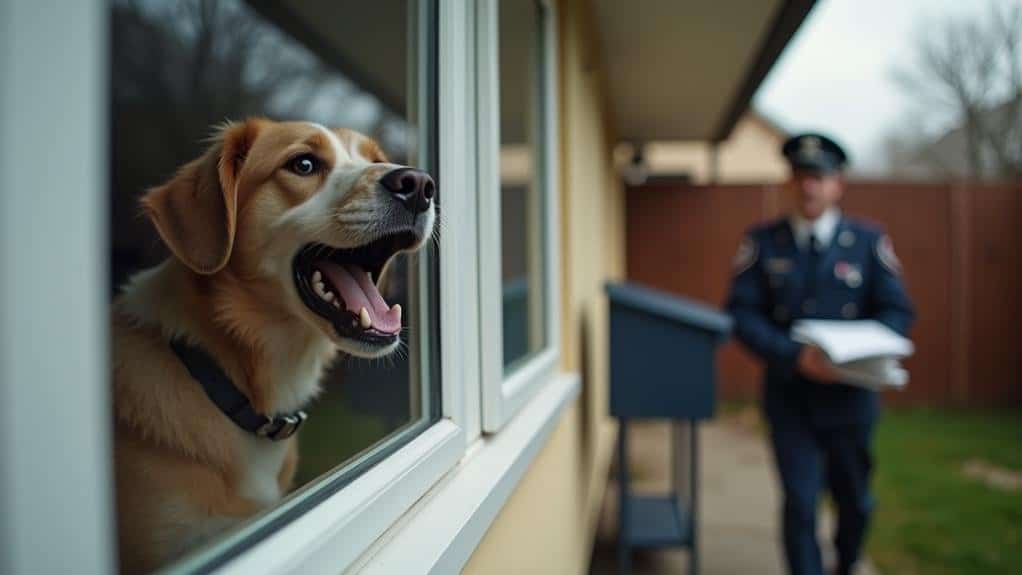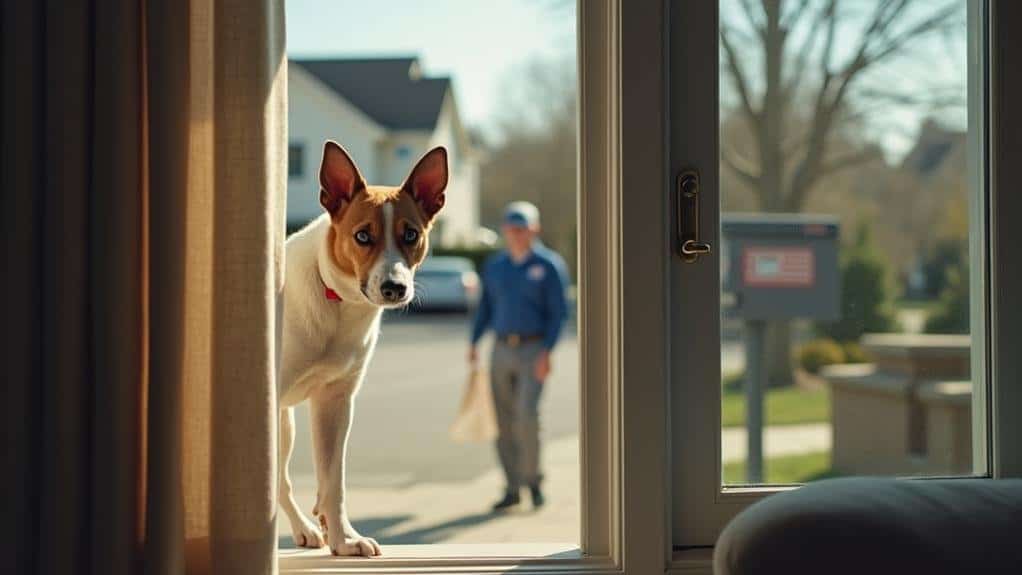Dogs don’t actually hate the postman—they’re just following their instincts and learned behaviors.
Your furry friend sees the mail carrier as an intruder in their territory, triggering protective responses like barking and growling.
This behavior gets reinforced when the “intruder” leaves after delivering mail. Over time, your dog associates the postal worker’s uniform, scent, and vehicle with anxiety and fear.
The daily routine of mail delivery intensifies these feelings, leading to stronger reactions. It’s not personal; your pup is just trying to keep their home safe.
Instinctive Territorial Behavior
Territoriality lies at the heart of the age-old conflict between dogs and postmen. Your furry friend’s instinctive territorial behavior stems from their wild canine ancestors, who fiercely defended their turf against intruders. This deeply ingrained instinct has carried over to modern dogs, shaping their interactions with postal workers and other delivery personnel.
When your dog sees a uniformed stranger approaching your home, their protective instincts kick into high gear. They view the postal worker as a potential threat to their territory, which now includes your house and property. This triggers defensive responses like barking, growling, and even aggressive behavior.
Here’s why this behavior persists:
- Alarm signals: Barking and growling serve as warnings to both you and the perceived intruder.
- Reinforcement: When the postal worker leaves after your dog barks, it reinforces the idea that their actions successfully defended the territory.
- Repeated encounters: Each interaction with postal workers strengthens your dog’s territorial response, creating a cycle of escalating aggressive behavior.
Understanding these instinctive behaviors can help you address and manage your dog’s reactions to postal workers more effectively.
Learned Responses and Reinforcement
While instinctive territorial behavior sets the stage, learned responses and reinforcement play a significant role in shaping your dog’s ongoing reactions to postal workers. Here’s how this process unfolds:
1. The Cycle of Reinforcement
Your dog barks at the mailman, and the mailman leaves. In your pup’s mind, their barking worked! This cycle repeats day after day, reinforcing the idea that barking is an effective way to protect their territory.
2. Cues and Triggers
Over time, your dog learns to associate specific cues with the mailman’s arrival. The sight of a uniform or the sound of a delivery vehicle can trigger your dog to act defensively before the mailman even approaches.
3. Escalation of Behavior
As this pattern continues, you might notice your dog’s reactions becoming more intense. What started as simple barking might escalate to lunging or even attempts to bite. This is why many dogs seem to hate the mailman with such passion.
4. Emotional Conditioning
Unfortunately, these repeated negative experiences can lead to a learned emotional response. Your dog may start to associate postal workers with stress or threat, further intensifying their aggressive behavior.
Fear and Anxiety Triggers

Numerous fear and anxiety triggers contribute to your dog’s negative reactions toward postal workers. Your furry friend’s instinctive territorial nature plays a big role in this behavior, as they perceive mail carriers as intruders entering their domain.
The combination of unfamiliar scents, unexpected noises, and the rapid approach of these uniformed visitors can send your dog into a state of heightened alertness and anxiety.
Here are four key factors that fuel your dog’s fear and anxiety towards postal workers:
- Visual cues: Distinctive uniforms and vehicles
- Auditory triggers: Sounds of approaching mail trucks
- Repetitive encounters: Daily visits reinforce negative associations
- Past trauma: Previous negative experiences, especially in shelter dogs
Your dog’s territorial instincts kick into high gear when they spot the mail carrier, leading to what you might perceive as “hate.” In reality, it’s a fear-based response rooted in their desire to protect their home and family.
The predictability of these visits can actually intensify your dog’s anxiety, as they learn to anticipate and react to the perceived threat. Understanding these triggers can help you address your dog’s fear and anxiety more effectively.
Misinterpretation of Postal Worker Actions

Despite postal workers’ benign intentions, dogs often misinterpret their actions as threatening. Your furry friend’s confusion stems from a few key factors:
1. Territorial Misunderstandings
When your postman approaches, your dog might see it as an invasion of their turf. This misinterpretation leads to defensive behaviors like barking and growling. It’s not personal; your pup’s just trying to protect their home!
2. Uniform Anxiety
The postman’s uniform can be a trigger for your dog’s anxiety. They associate that familiar outfit with an unfamiliar person, which can lead to generalized fear of all delivery workers.
3. Reinforced Negative Associations
Here’s where things get tricky. When your dog barks and the postman leaves, your pup thinks, “Hey, my aggressive behavior worked!” This reinforces their belief that barking is effective, creating a cycle of negative associations.
4. Escalating Reactions
Simple actions like stopping at the mailbox or approaching your door can escalate your dog’s anxiety. Over time, these misunderstandings can lead to more pronounced reactions, making each encounter seem more threatening than the last.
Solutions for Reducing Canine Aggression
After understanding why dogs react negatively to postal workers, it’s time to explore effective solutions for reducing canine aggression.
You can take several steps to help your furry friend become more comfortable with mail carriers and prevent aggressive behaviors.
Here’s a list of four effective strategies:
- Gradual exposure with positive reinforcement
- Consistent training using desensitization techniques
- Blocking your dog’s view of the delivery area
- Engaging a professional animal behaviorist
One of the most powerful tools in your arsenal is classical counter-conditioning. This involves pairing the presence of the postal worker with something your dog loves, like treats or toys. Over time, your pup will start to associate mail carriers with positive experiences, rather than perceiving them as threats.
Establishing a routine where your dog receives rewards for calm behavior during mail deliveries can work wonders. This positive reinforcement helps your furry friend understand that staying relaxed is the way to go.
Frequently Asked Questions
Why Do Dogs Dislike the Postman?
Your dog sees the postman as an intruder. They’re triggered by the uniform and routine visits. When the postman leaves after your dog barks, it reinforces the belief that barking worked. This creates a cycle of hostility.
Why Do Dogs Hate Mailman so Much?
You’ll find that dogs don’t actually hate mailmen. They’re reacting to perceived threats to their territory. Your dog’s barking seems to “work” as the mailman always leaves, reinforcing this behavior over time.
How Do I Get My Dog to Stop Attacking the Postman?
You’ll need to use gradual desensitization and positive reinforcement. Reward your dog for calm behavior when the postman arrives. Create a safe space during deliveries, and work on threshold training. Consider hiring a professional animal behaviorist if needed.
Why Do Dogs Go Crazy for the Mailman?
Your dog’s excitement for the mailman stems from their territorial instincts. They see the regular visits as a potential threat. The uniform, vehicle, and predictable schedule trigger their guarding behavior, causing them to react intensely to protect their home.

